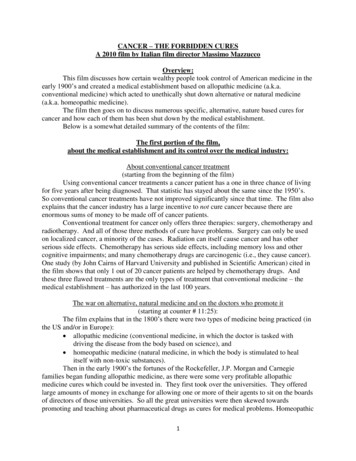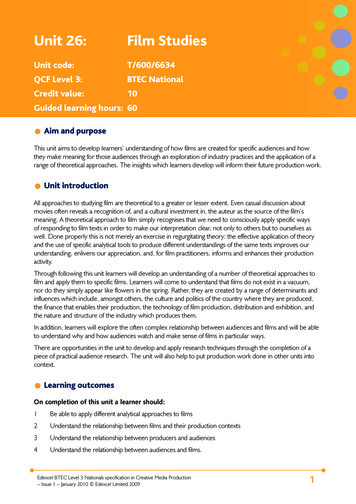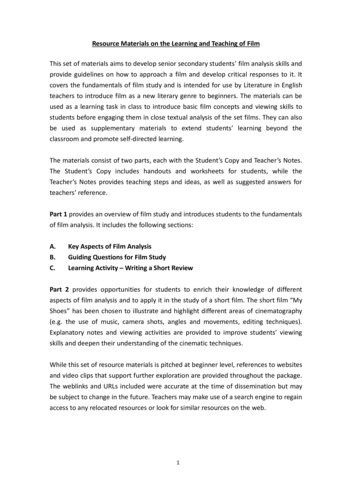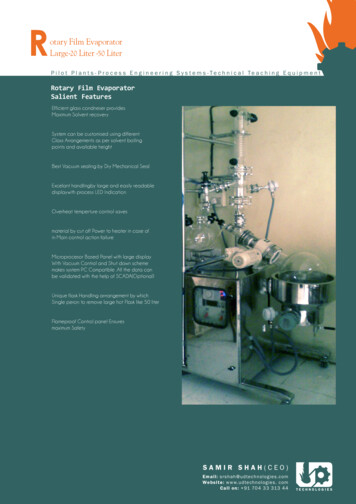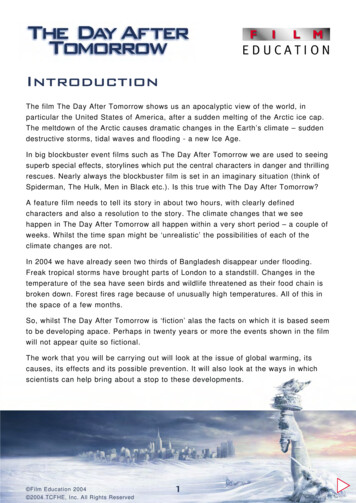
Transcription
IntroductionThe film The Day After Tomorrow shows us an apocalyptic view of the world, inparticular the United States of America, after a sudden melting of the Arctic ice cap.The meltdown of the Arctic causes dramatic changes in the Earth’s climate – suddendestructive storms, tidal waves and flooding - a new Ice Age.In big blockbuster event films such as The Day After Tomorrow we are used to seeingsuperb special effects, storylines which put the central characters in danger and thrillingrescues. Nearly always the blockbuster film is set in an imaginary situation (think ofSpiderman, The Hulk, Men in Black etc.). Is this true with The Day After Tomorrow?A feature film needs to tell its story in about two hours, with clearly definedcharacters and also a resolution to the story. The climate changes that we seehappen in The Day After Tomorrow all happen within a very short period – a couple ofweeks. Whilst the time span might be ‘unrealistic’ the possibilities of each of theclimate changes are not.In 2004 we have already seen two thirds of Bangladesh disappear under flooding.Freak tropical storms have brought parts of London to a standstill. Changes in thetemperature of the sea have seen birds and wildlife threatened as their food chain isbroken down. Forest fires rage because of unusually high temperatures. All of this inthe space of a few months.So, whilst The Day After Tomorrow is ‘fiction’ alas the facts on which it is based seemto be developing apace. Perhaps in twenty years or more the events shown in the filmwill not appear quite so fictional.The work that you will be carrying out will look at the issue of global warming, itscauses, its effects and its possible prevention. It will also look at the ways in whichscientists can help bring about a stop to these developments. Film Education 2004 2004 TCFHE, Inc. All Rights Reserved1
Causes of Global WarmingThe Greenhouse EffectGlobal warming occurs through the process dubbed the ‘greenhouse effect’. The earthis enclosed and surrounded by a layer of gas in the atmosphere that insulates it, likethe glass of a greenhouse.This layer of gas traps heat around the earth and prevents it from escaping, which isessential to the continuation of life on earth. Without the insulating layer the earthwould be 33 C colder and life as we know it could not be sustained. So thegreenhouse effect has always been around and is an important part of life.Heat is trapped in the following way: visible radiation (sunlight) enters the earth’satmosphere and warms it, and although some heat (infrared radiation) escapes again,much is trapped by, and stored in, this insulating layer. This process can be split intostages:1.Solar radiation passes through the clearatmosphere.2.Most radiation is absorbed by the Earth's surfaceand warms it.3.The Earth and the atmosphere reflect some solarradiation.4.Infrared radiation (heat) is emitted from theEarth's surface.5.Some of the infrared radiation is absorbed andre-emitted by the greenhouse gases.The effect of this is to warm the surface and lower atmosphere. Film Education 2004 2004 TCFHE, Inc. All Rights Reserved2
Greenhouse GasesThe insulating layer of gas around the earth is made up of several different gases. Themain ‘greenhouse gases’ in order of significance are: carbon dioxide (CO2 ), methane(CH4 ), nitrous oxide (N2 O), chlorofluorocarbons, or CFC’s and ozone (O3 ).Greenhouse gases are essential to the continuation of life on earth, by trapping heat.Most of these gases occur naturally and a balance of carbon dioxide is maintained bythe carbon cycle. Some carbon dioxide is produced by burning of hydrocarbons (suchas occurs naturally in forest fires) and animals’ respiration and some is converted backto oxygen by plants’ photosynthesis.Oxygen is converted to Carbon DioxideBurning (of hydrocarbons): natural gas oxygenwater carbon dioxide energy[combustion]CH4 2O2 glucose oxygen 2H2 O CO2Respiration:C6 H1 2O6 6O2carbon dioxide water energy 6CO2 6H2 OCarbon Dioxide is converted to OxygenPhotosynthesis:water carbon dioxide6H2 O 6CO2 glucose oxygen C6 H1 2O6 6O2Normally, this layer of gas is maintained at a regular thickness by this natural balance.However, greenhouse gases can also be produced by human activities. Film Education 2004 2004 TCFHE, Inc. All Rights Reserved3
Carbon dioxide (CO2 ) is the main gas that makes up the greenhouse layer, and as wellas being naturally produced in forest fires, can be produced in large quantities bydeliberate burning of fossil fuels such as coal, petrol, oil and gas. Global warming hasbeen observed primarily in the twentieth century, following the Industrial Revolutionaround two centuries ago, when large-scale industry and energy production started,and it is developed or industrial nations that produce by far the most CO2 emissions(see table on page 6). In the last twenty years, three quarters of human-made(anthropogenic) carbon dioxide emissions have been from burning fossil fuels.These CO2 emissions are mostly produced by big industries across the world,particularly power stations where fossil fuels are burned to produce energy. Cars andother motorised vehicles, which also burn petrol to produce energy, also producesignificant amounts. Industrial processes also produce other greenhouse gases. Film Education 2004 2004 TCFHE, Inc. All Rights Reserved4
Sources of Greenhouse GasesCarbon Dioxide (CO2 )Produced by respiration and the burning ofhydrocarbons (including fossil fuels)Methane (CH4 )Produced by burning of fossil fuel, livestock farming,rice cultivation and waste managementN2 O (Nitrous Oxide)Produced by burning of fossil fuel, sewage treatmentand agricultural soil managementCFC’s (Chlorofluorocarbons)Spray cans, coolants in refrigerators and airconditionersO3 (Ozone)Formed from volatile organic compounds (VOC’s)produced by power plants and the chemical industryTaskFor each of the above emissions, think of as many industries and daily humanactivities that contribute to the build up of harmful gases in the atmosphere. Atthis stage, try to think of one way of combating each of these emission buildups. Then, think of the way that your method of combating the build up of eachemission might change the way in which we live.This increased emission of greenhouse gases has resulted in an excessive build-up ofthese gases and the consequent thickening of the insulating layer. This is causing anunprecedented accumulation of heat that cannot pass through, sometimes called theenhanced greenhouse effect.TaskIf the temperature of Earth is increasing then what do you think could be someof the possible effects of this? In groups, try to write a list of effects of globalwarming. From your list, compare what you think are the effects with some ofthe climate changes shown in the film The Day After Tomorrow. Film Education 2004 2004 TCFHE, Inc. All Rights Reserved5
In the last couple of centuries, huge tracts of forests and rainforests have been cutdown to create fields for farming, particularly cattle-grazing. This large-scaledeforestation is responsible for a reduction in the amount of CO2 converted to oxygenby photosynthesis. So not only do people burning fossil fuels produce more CO2 , butalso less CO2 is removed from the atmosphere by plants, further changing the delicatebalance of the natural carbon cycle. Humans produce 6.1 billion metric tonnes ofcarbon dioxide emissions annually (measured in carbon equivalent terms), but 3.2billion metric tonnes are not absorbed and are added to the atmosphere each year.Greenhouse gas emissions are expected to grow at an average of 1.9% per annumbetween 2001 and 2025.Carbon Dioxide (CO2) EmissionsCountryCO2 emissions fromPer capita CO2 emissionsfuel combustionin ed Kingdom5419.20Canada52016.72South Korea4369.21Italy4257.34As the table shows, the main producers of CO2 are either highly developed countriesor densely populated ones that have heavy industry and a great per capita demandfor energy production. The USA emits 20-25% of global emissions. In 1997 aninternational summit was held in Kyoto, Japan, to control emissions, at which the USArefused to agree to cut emissions. Almost all other developed countries have signedan agreement to cut CO2 emissions by 5.2% (from 1990 levels) by 2012. Film Education 2004 2004 TCFHE, Inc. All Rights Reserved6
TaskWhy do you think that the USA refused to cut CO2 emissions? If emissions areproduced by industry, what does this tell us about the economy of the USA andwhy they might put pressure on the government not to cut the rate ofemissions?A Note on the Ozone LayerPeople have become confused by the difference between the ozone layer and thegreenhouse effect. Although ozone is a greenhouse gas, the two environmentalproblems are completely different! The ozone layer is a thin layer of the gas ozone(O3 ) in the upper atmosphere that protects the earth from ultraviolet radiation.Because of man-produced chemicals such as CFC’s (which are also, confusingly,greenhouse gases!), this layer is thinning and breaking up and allowing more harmfulultraviolet radiation through which causes skin cancer. Film Education 2004 2004 TCFHE, Inc. All Rights Reserved7
Effects of Global WarmingOver the course of the twentieth century, there has been an overall 0.6 C rise intemperature globally, and in recent years the change in climate and weather hasbecome more apparent even in the British Isles. The global climate often undergoesslight fluctuation in temperature, but warming in the twentieth century was greaterthan at any time in the last 400-600 years. This is thought to be due to increasedcarbon emissions from the burning of fossil fuels since the Industrial Revolution in theearly nineteenth century. Seven of the ten warmest years of the century occurred inthe 1990s and 1998 was the hottest year on record, followed by 2000 and 2001.The film The Day After Tomorrow is a fictional representation of the kind of weatherconditions that could result from global warming. The conditions that global warmingproduces are unprecedented in world history and the effects are difficult to predict,although attempts are being made using computer-generated models, and the processmay slow if CO2 emissions are significantly cut. It is important to remember that theextreme weather of the film’s hypothesis could indeed be a possible result ofwarming. However, global warming is already affecting the climate in a way that is notso immediately apparent, but is nevertheless dramatic for the delicately balancedecosystems of the globe.Physical EffectsAs the name suggests, the main feature of global warming is an increase intemperature as heat is trapped under the layer of carbon dioxide that surrounds theglobe. Fires are more common in hot areas that, due to global warming, become drier.These fires can be destructive to whole regions, forests, crops, and the animals andpeople that depend upon them. Also, increased temperature causes the melting oflarge bodies of ice. Film Education 2004 2004 TCFHE, Inc. All Rights Reserved8
Arctic Warming & Polar Ice CapsAt the extreme north and south of theglobe, areas such as Alaska, Siberiaand the Arctic and Antarctic haveundergone more accelerated warmingthan the rest of the globe. Forexample, the Antarctic Peninsula hasexperienced warming of five times theglobal average, at 2.5 C over the lastforty-five years.Antarctica itself (which contains 90%of the world’s ice) is unlikely to melt,as the average temperature is –37 C.If it did, sea levels would rise around61 metres. However, large sections ofice periodically break off from itscoastline and melt in the sea, aprocess greatly increased by warming.The increased ocean temperature alsocauses the melting of floating sea ice.Large ice masses have been slowlymelting in the last century, and therehave been several dramatic collapseevents recorded, such as the 35 daydisintegration of the northern section of the Larsen B ice shelf in Antarctica, an areaof 3,238 km2 . The melting of polar ice, as well as raising sea levels, affects thebalance of freshwater in the oceans against the amount of saltwater, a theory used inthe film.NASA satellites have shown that the area of permanent ice cover in the Arctic isdecreasing at a rate of 9% each decade. At that rate, by 2100 there will be no ice inthe Arctic summer. The melting of permafrost has also exposed the soil beneath toerosion and has increased the risk of landslides as well as necessitating thereconstruction of many buildings and roads. Sea ice and ice shelves also melt,reducing the habitat of wildlife in those areas. Film Education 2004 2004 TCFHE, Inc. All Rights Reserved9
Rise in Sea LevelGlobal warming also greatly affects the oceans, which cover around 70% of theEarth’s surface. Increased heat causes the water particles to vibrate more vigorouslyand the water expands in volume, causing the sea level to rise. Due partly to themelting of polar ice caps and partly to the thermal expansion of water, sea levels havebeen shown to be rising. According to sea level rise (SLR) data collected fromthroughout the globe over the past hundred years the sea level has risen between10cm and 25cm. This produces several knock-on effects on coastal regions, erodingcoastline and causing the loss of beaches. On average, for every 30cm rise in sealevel, 15-30 metres of beach are lost.In 1995 the Intergovernmental Panel on Climate Change issued a report thatcontained various projections of the sea level change by the year 2100. Theyestimate that the sea will rise 50cm with the lowest estimates at 15cm and thehighest at 95cm. This rise of 50cm could have a big effect on coastal cities,especially during storms and could cause widespread flooding. Film Education 2004 2004 TCFHE, Inc. All Rights Reserved10
TaskLook at an Ordnance Survey map o
Introduction The film The Day After Tomorrow shows us an apocalyptic view of the world, in particular the United States of America, after a sudden melting of the Arctic ice cap. The meltdown of the Arctic causes dramatic changes in the Earth’s climate – sudden destructive storms, tidal waves and flooding - a new Ice Age. In big blockbuster event films such as The Day After Tomorrow we are .
